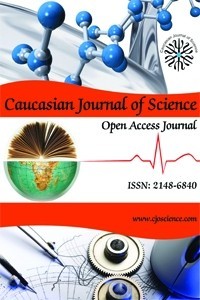EFFECTS OF ALUMINIUM POISONING ON SERUM PROTEINS AND GILL HISTOPATHOLOGY OF CAPOETA CAPOETA (GULDENSTAEDT 1773)
Abstract
In this study, effects on gill histopathology and serum proteins in Capoeta capoeta of Aluminium chloride (AlCl3) intoxication were examined. Fish caught from the Kars Creek were placed in 300-liter tank and allowed to stand for 10 days. Then, three groups were formed seven pieces of fish in each group. The fish in the first group was the control group. Fish in II. and III groups were exposed to 0.03 and 0.06 mg/L AlCl3 for 10 day, respectively. Then, blood and tissue samples from fish were taken. Serum samples were run in sodium dodecyl sulfate polyacrylamide gel electrophoresis (SDS-PAGE). Gill tissues were detected in the 10% formaldehyde solution. After preparing paraffin blocks by routine histological techniques, slices were taken at 3-5 thickness and slices were stained with hematoxylin and eosin and examined by light microscopy. In SDS-PAGE, according to protein bands of the fish in the control group, thinning in 59 kD protein band and thickening in 94, 74, 46 and 35 kD protein band of fish applied 0.03 mg/L AlCl3 were seen to occur. Expression of 71 kD protein band was lack. Thinnings in 101, 74, 71, 59, 46 and 26 kD protein bands and thickening in 94 kD protein band of fish exposed 0.06 mg/L AlCl3 were observed expression of 86 kD protein band was lack. In histopathological examination, in group treated 0.03 mg/L AlCl3 was observed degeneration in the epithelial cell of secondary lamellae, in group treated 0.06 mg/L AlCl3 was determined degenerations in the epithelial cells of secondary lamellae, as well as hyper cellularity and blunt-recovery in ends of some secondary lamellae were seen. In the present study, it was concluded that applications of 0.03 and 0.06 mg/L AlCI3 could be a toxic for health of Capoeta capoeta.
References
- Çalta, M. (1999). The effects of toxic aluminium and low ph on gill development of rainbow trout (Oncorhynchus mykiss, Walbaum) larvae. Turkish Journal of Zoology, 23, 285-291.
ALÜMİNYUM ZEHİRLENMESİNİN CAPOETA CAPOETA (GULDENSTAEDT 1773)’NIN SERUM PROTEİNLERİ VE SOLUNGAÇ HİSTOPATOLOJİSİ ÜZERİNE ETKİLERİ
Abstract
Bu çalışmada, Alüminyum klorür (AlCl3) zehirlenmesinin Capoeta capoeta’nın serum proteinleri ve solungaç histopatolojisi üzerindeki etkileri incelendi. Kars Çayı’ndan yakalanan balıklar 300 litrelik tanklara konuldu ve 10 gün süreyle bekletildi. Daha sonra her grupta 7 adet balık bulunan 3 grup oluşturuldu. I. gruptaki balıklar kontrol grubu, II. ve III. gruptaki balıklar ise sırasıyla 0.03 ve 0.06 mg/L AlCl3’e 10 gün süreyle maruz bırakıldı. Sonra, balıklardan kan ve doku örnekleri alındı. Serum numuneleri sodyum dodesil sülfat poliakrilamid jel elektroforezi (SDS-PAGE)’de yürütüldü. Solungaç dokuları ise %10’luk formaldehit solüsyonunda tespit edildi. Bilinen histolojik yöntemlerle parafin bloklar hazırlandıktan sonra, 3-5 kalınlığında kesitler alındı ve kesitler hematoksilen ve eosinle boyanarak ışık mikroskobunda incelendi. SDS-PAGE’de kontrol grubundaki balıkların protein bantlarına göre, 0.03 mg/L AlCl3 uygulanan gruptaki balıkların 59 kD’luk protein bandında incelme, 94, 74, 46 ve 35 kD’luk protein bantlarında kalınlaşmalar meydana geldiği görüldü. 71 kD’luk protein bandının ise sentezlenmediği tespit edildi. Yine kontrol grubu balıklara göre, 0.06 mg/L AlCl3 uygulanan gruptaki balıklarda 101, 74, 71, 59, 46 ve 26 kD’luk protein bantlarında incelme ve 94 kD’luk protein bandında kalınlaşma gözlendi. 86 kD’luk protein bandının da sentezlenmediği saptandı. Histopatolojik incelemelerde, 0.03 mg/L AlCl3 uygulanan gruptaki balıkların sekonder lamellerinin epitel hücrelerinde dejenerasyon, 0.06 mg/L AlCl3 uygulanan gruptaki balıkların sekonder lamellerinin epitel hücrelerinde dejenerasyon, ayrıca hipersellülarite ve bazı sekonder lamellerin uçlarında kütleşme görüldü. Bu çalışma da, 0.03 ve 0.06 mg/L’lık AlCI3 uygulamasının Capoeta capoeta için toksik olduğu sonucuna varıldı.
References
- Çalta, M. (1999). The effects of toxic aluminium and low ph on gill development of rainbow trout (Oncorhynchus mykiss, Walbaum) larvae. Turkish Journal of Zoology, 23, 285-291.
Details
| Primary Language | Turkish |
|---|---|
| Journal Section | Articles |
| Authors | |
| Publication Date | December 31, 2018 |
| Submission Date | September 11, 2018 |
| Acceptance Date | December 30, 2018 |
| Published in Issue | Year 2018 Volume: 5 Issue: 2 |







